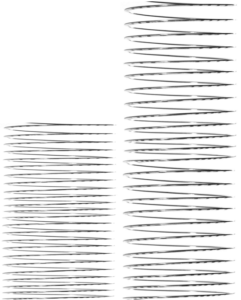Your cart is currently empty!
What kinds of images can RESTORE fix?

And where is my slinky? More on that later.
Here are a few guidelines for what types of images can be helped most successfully by RESTORE.
Fade types
Any time you can “study” the original print and see many different colors, even though they may be badly faded and have the wrong hue, you will probably be able to bring back those colors with RESTORE.
The best analogy I’ve found is that of a slinky. You remember…the toy we all had that could walk down a stairway all by themselves (until it got bent, and then there was no way to ever make it bend back to be good as new. Yes, I’m old enough to have had a metal one.). In the same manner in which you can see all the all the coils of a slinky, even when it is not spread wide, the colors in each channel are still there for improvement. When you pull a slinky apart, you can more easily see the coils. The same is true with the “tone scale” of the print or slide. If there are different colors there to begin with, even if they are very closely alike, with RESTORE you can “pull them apart” like a slinky. This makes all the colors easier to see, and also more balanced like a real scene.
The same is true for black and white images…except that there is only one “channel” or color to deal with.
Resolution and file size
In general, the larger the file size from the scan, the better off you are. But that is not always true, since scanning at resolutions that are greater than what is “available” from the print or slide is just wasting bits and memory. The rule of thumb for a print is 300 pixels per inch. Most historical photo systems are limited, due to taking lenses on cameras, film flatness in the camera, printing lenses, processing, etc. to little more than 200 pixels per inch, so using 300 pixels per inch usually gives great results. So for a 3” buy 3” picture, 600 by 600 pixels is usually good enough for the scan…900 by 900 is probably going to give you more than all the resolution available.
For transparencies (slides and negatives), the scanning resolution is much higher. Anything over 1000 pixels per inch should give decent results. If you have any large format negatives (like 4″ by 5″), you need not scan at resolution that high, but sometimes there is amazing detail in such large negatives, so you may still want to scan at a high resolution.
Print Size
If you have a teeny-tiny little image of your Great-grandfather, it is usually a good idea not to make the restored image much bigger than the original, even if you have scanned it at high resolution. If you blow it up to a much larger size, you’ll run the risk of having the image look out of focus or pixelated. 2X is usually about as far as you can go without seeing problems.
Negatives and slides, however, are designed to be enlarged. If your original negative or slide was well captured and is in good focus, a magnification of 10 to 1 is reasonable. (RESTORE does not currently work with negatives. Feel free to let us know that we need to change that. We’ll be sure to include the feature as soon as 500 people tell us so.)
In focus
RESTORE can help sharpness, but if the photo is really blurry to begin with, there is not all that much that can be done. It’s best to start with an image that has decent sharpness, even if faded. If, with the naked eye, you can see that the image is not sharp, it is not a great candidate for improvement. However, if this is the only picture you have of Uncle Waldo, go ahead regardless. The sharpening will help some.
Visual noise
“Noise” is the term given to unwanted signals. Engineers and Scientists stay up late dreaming up these names. “Hey, Charlie, let’s call the garbage in the picture ‘noise.’ Yeah, I know it doesn’t make a sound, but it will make us sound really smart to misuse a term like that.”
If there is damage to the photo (tears, creases, folds, scratches), or if the storage of the photo over time has introduced speckles or water damage or other such point or line defects, it will be difficult to restore the photo. This kind of photo will need professional help, which is beyond the current capabilities of RESTORE.
Additionally, there are certain types of photo surface finishes that make improvement difficult. Any kind of textured surface will introduce its own unwanted “noise”. Smooth surfaces, like glossy prints, are preferred.
Hope this helps you determine which photos you may want to help with RESTORE.
